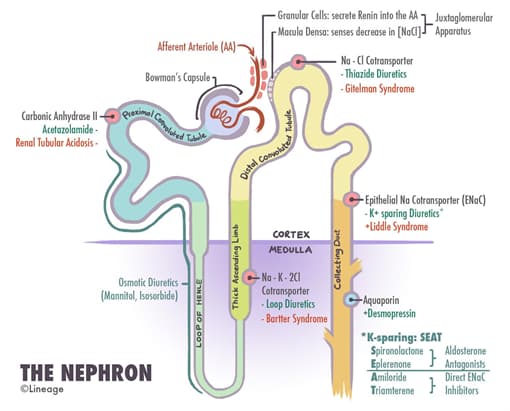Overview

Snapshot
- A 46-year-old man with a history of focal segmental glomerulosclerosis presents with worsening edema. His dose of furosmemide is increased and he has improvement of his symptoms. Later that week he has routine lab work drawn, and a basic metabolic panel shows an increased serum bicarbonate level. (Contraction alkalosis)
Sodium
- Hyponatremia with all classes of diuretics
- diuretics act by increasing urine sodium
- serum sodium may decrease as a result
Potassium
- Hypokalemia
- loop diuretics and thiazide diuretics
- due to increased potassium excretion from increased sodium delivery to the cortical collecting tubule
- loop diuretics and thiazide diuretics
- Hyperkalemia
- potassium-sparing diuretics
- due to decreased potassium secretion in the cortial collecting tubule
Blood pH
- Acidemia
- carbonic anhydrase inhibitors
- bicarbonate is secreted and acid is retained
- potassium-sparing diuretics
- prevent protons from being secreted by indirectly reducing the activity of the proton ATPase on the apical membrane
- additionally, hyperkalemia from potassium-sparing diuretics causes potassium ions to enter all cells in exchange for protons, further decreasing serum pH
- prevent protons from being secreted by indirectly reducing the activity of the proton ATPase on the apical membrane
- carbonic anhydrase inhibitors
- Alkalemia
- loop diuretics and thiazides
- volume contraction stimulates the angiontensin II, promoting sodium/proton exchange in the proximal convoluted tubule (PCT), and increases bicarbonate reabsorption
- loop diuretics and thiazides
- additionally, hypokalemia results in potassium leaving all cells in exchange for protons, which enter cells, further increasing serum pH
Urine Calcium
- Hypercalciuria
- Hypocalciuria
- thiazides
- enhanced calcium reabsorption at both proximal and distal tubules, also causing hypercalcemia
- proximal tubule
- thiazide-induced volume depletion causes enhanced sodium and passive calcium reabsorption
- distal tubule
- decreased intracelluluar sodium levels cause increased sodium/calcium exchange at the basal membrane, increasing calcium concentration in the interstitium
- proximal tubule
- enhanced calcium reabsorption at both proximal and distal tubules, also causing hypercalcemia
- thiazides



